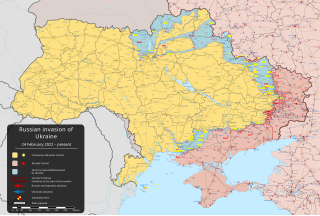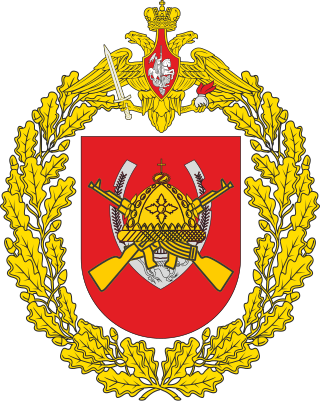
The role of open-source intelligence (OSINT) in response to the 2022 Russian invasion of Ukraine has attracted significant attention. [1] [2] [3] [4] [5] [6]

The role of open-source intelligence (OSINT) in response to the 2022 Russian invasion of Ukraine has attracted significant attention. [1] [2] [3] [4] [5] [6]
Open-source intelligence (also known by its acronym OSINT) refers to the gathering and analysis of intelligence based on publicly available sources of information.
In the early hours of 24 February, just before the start of the invasion, OSINT researchers at the Middlebury Institute of International Studies at Monterey used Google Maps to track a significantly large traffic jam on a road in Russia leading to the Ukrainian border. Jeffrey Lewis subsequently tweeted "someone’s on the move." An hour later, Russian troops began the invasion. [7] [8]
Netherlands-based investigative journalism group Bellingcat has published interactive maps of destroyed civilian targets and has worked on authenticating potential documentation of war crimes. [9] [10] [11] In July 2022, Bellingcat was banned as an undesirable organisation by the Russian government, with the Prosecutor-General of Russia saying that it posed "a threat to the security of the Russian Federation." [12]
Oryx gained international prominence through its work during the 2022 Russian invasion of Ukraine, counting and keeping track of material losses based on visual evidence and OSINT from social media. [13] [14] [15] It has been regularly cited in major media, including Reuters, [16] BBC News, [17] The Guardian, [18] The Economist, [19] Newsweek, [20] CNN, [21] and CBS News. [22] Forbes has called Oryx "the most reliable source in the conflict so far", calling its services "outstanding". [23] [24] [25] Because it reports only visually confirmed losses, Oryx's tallies of equipment losses have formed absolute minimum baselines for loss estimates. [26] [23]
The Free Buryatia Foundation, which was founded in opposition to the invasion, has used open-source intelligence to try to track the number of Buryats killed in action in Ukraine. As of April 2022, the Foundation has estimated that around 2,8% of Russian casualties were Buryat, one of the highest death tolls among the Russian federal republics. [27]
The HALO Trust, the world's largest mine clearance charity, has also conducted open source research into the conflict to understand the types of weapons used and the subsequent contamination across Ukraine, which requires clearance. [28] [29] [30] [31]
OSINT groups have also used tools such as facial recognition apps to try to identify perpetrators of war crimes, such as the Bucha massacre. [32]
The sharing of open-source intelligence on social media has raised ethical concerns, including over the sharing of graphic images of bodies and of potentially military-sensitive data. [33] Matthew Ford of the University of Sussex has noted that "Ukrainians fear such images will reveal their tactics, techniques, and procedures," and that Ukrainians have therefore undertaken a degree of self-censorship. [34] Concerns have also been raised about the potential dissemination of misinformation, such as through fake accounts posing as insider sources. [35]
Open-source intelligence (OSINT) is the collection and analysis of data gathered from open sources to produce actionable intelligence. OSINT is primarily used in national security, law enforcement, and business intelligence functions and is of value to analysts who use non-sensitive intelligence in answering classified, unclassified, or proprietary intelligence requirements across the previous intelligence disciplines.

The 200th Separate Motor Rifle Brigade is a military formation of the 14th Army Corps, part of the Northern Military District, based at Pechenga in Murmansk Oblast. The brigade was formed from the 131st Motor Rifle Division in 1997 and was one of the two Russian Arctic warfare brigades.

Eliot Ward Higgins, who previously wrote under the pseudonym Brown Moses, is a British citizen journalist and former blogger, known for using open sources and social media for investigations. He is the founder of Bellingcat, an investigative journalism website that specialises in fact-checking and open-source intelligence. He has investigated incidents including the Syrian Civil War, the Russo-Ukrainian War, the downing of Malaysia Airlines Flight 17 and the poisoning of Sergei and Yulia Skripal. He first gained mainstream media attention by identifying weapons in uploaded videos from the Syrian conflict.

Igor Nikolayevich Bezler, known by the pseudonym "Bes" is one of the pro-Russian rebel leaders whose group controlled the local police department in Horlivka.
Bellingcat is a Netherlands-based investigative journalism group that specialises in fact-checking and open-source intelligence (OSINT). It was founded by British journalist and former blogger Eliot Higgins in July 2014. Bellingcat publishes the findings of both professional and citizen journalist investigations into war zones, human rights abuses, and the criminal underworld. The site's contributors also publish guides to their techniques, as well as case studies.
The Insider is an independent online newspaper specializing in investigative journalism, fact-checking and political analytics. Founded in 2013 by Roman Dobrokhotov, journalist and political activist, who is the owner of the newspaper. The newspaper is known for exposing fake news in Russian media. The editorial office of the website is located in Riga, Latvia. Andris Jansons is the editor-in-chief of the website.

On 24 February 2022, Russia invaded and occupied parts of Ukraine in a major escalation of the Russo-Ukrainian War, which began in 2014. The invasion has resulted in tens of thousands of deaths on both sides and instigated Europe's largest refugee crisis since World War II. About 8 million Ukrainians were displaced within their country by June, and more than 8.1 million had fled the country by March 2023.

The eastern Ukraine campaign is a theatre of operation in the ongoing 2022 Russian invasion of Ukraine that affects three oblasts in eastern Ukraine: Donetsk Oblast and Luhansk Oblast and Kharkiv Oblast. The invasion is an escalation or intensification of the Russo-Ukrainian War, which had been waged between Ukraine and Russian proxies since 2014.
Vitaly Petrovich Gerasimov is a Russian Ground Forces major general, the chief of staff and first deputy commander of the 41st Combined Arms Army.
The battle of Volnovakha was a military engagement which lasted from 25 February 2022 until 12 March 2022, as part of the Eastern Ukraine offensive during the 2022 Russian invasion of Ukraine. Russian and DPR forces engaged Ukrainian forces at the small city of Volnovakha in Donetsk Oblast, which is located close to the Ukrainian-DPR border.

The 37th Separate Guards Motor Rifle Don Cossack Budapest Red Banner Order of the Red Star Brigade named after Ye. A. Shchadenko is a motor rifle brigade of the Russian Ground Forces. It is stationed at Kyakhta in Buryatia, part of the 36th Combined Arms Army of the Eastern Military District. The brigade fought in the war in Donbas and the 2022 Russian invasion of Ukraine.

Manisha Ganguly is an investigations correspondent at The Guardian, specialising in Open Source intelligence. She previously worked as investigative documentary producer for the BBC, where she won multiple awards for her work exposing war crimes. She lives in London, United Kingdom.

On 8 April 2022, a Russian missile strike hit the railway station of the Ukrainian city of Kramatorsk during the Russian invasion of Ukraine. The strike killed 60 civilians and wounded more than 110. Russian authorities denied responsibility and blamed the attack on Ukraine.

Oryx, or Oryxspioenkop, is a Dutch open-source intelligence (OSINT) defence analysis website, and warfare research group. It is run by Stijn Mitzer and Joost Oliemans. Both have previously worked for Netherlands-based Bellingcat. Oliemans also worked for Janes Information Services, a British open-source military intelligence company.

The National Open Source-Intelligence Agency (NOSA) is a proposed 19th member of the United States Intelligence Community (IC) to be tasked with the collection and exploitation of open-source intelligence (OSINT). Creation of the agency would consolidate open source efforts across the US government into a new functional manager for the open-source intelligence discipline, drawing resources from the Open Source Enterprise of the Central Intelligence Agency, the Open Source Integration Center (OSIC) of the Defense Intelligence Agency, the National Geospatial-Intelligence Agency, as well as other open source focused entities across the government.

The Free Buryatia Foundation is an advocacy group focused on the Russian federal subject of Buryatia. The foundation is located in Alexandria, Virginia, United States.
Oryx, a closely watched military blog which tallies both sides' losses based on verifiable visual evidence